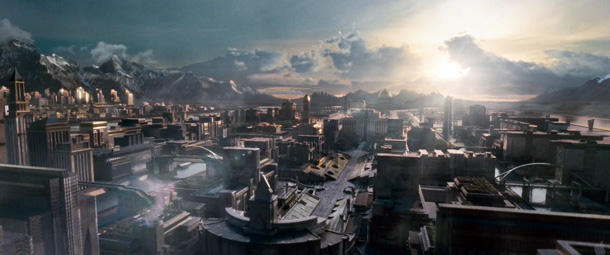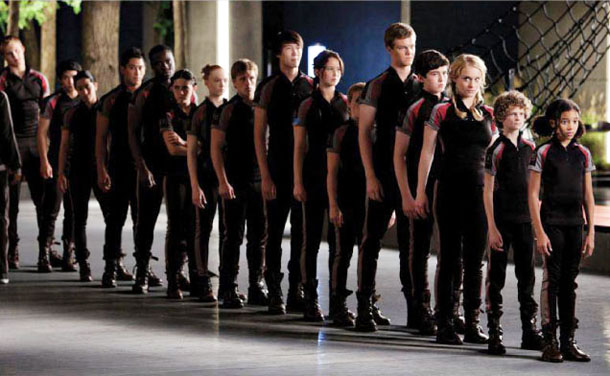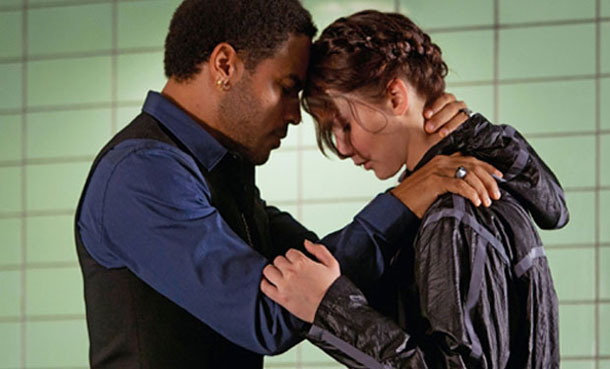
Ever since it was announced that director Gary Ross won the job of adapting Suzanne Collins’s beloved Young Adult The Hunger Games novel to screen, the 25 million (and counting) readers of the trilogy have been fretfully willing him not to screw it up. That’s a lot of pressure to weigh on the shoulders of a man that actively sold himself as the right person to bring Katniss Everdeen to life, but with the film ready to open, Ross is confident and hopeful that his love and respect for the book shines through.
Ross talks exclusively to SFX in issue #220 (available 7 March) about the process of adapting the book, but our chat went on a lot longer than our print story. Here’s the rest of our exclusive interview with Ross where he talks about casting big names like Donald Sutherland and musician Lenny Kravitz, the toughest bits to shoot and a late composer swap around.
SFX : You’ve done the book-to-screen process before with Seabiscuit but how different an animal was The Hunger Games ?
Gary Ross: “I have a much closer relationship with Suzanne (Collins) than I had with [ Seabiscuit author] Laura Hillenbrand. In fact, Suzanne and I wrote the last pass of the screenplay together.”
Passionate fans sometimes forget that you can’t do a literal book translation for film, so did you feel the pressure of knowing your screenplay was going to disappoint some purist readers?
Gary Ross: “First of all, I’m a fan, so pleasing myself is half the battle. Obviously the fact that Suzanne loved it instilled in me that I had been properly calibrated and my tonal sense of the material was coming through. In terms of pressure, I don’t know. I felt an excitement and opportunity to dive into something that I love. Anytime you write or direct anything you are also the audience or the reader. You want to give them the same thrill you had when you first read the book.”
From the time the film was announced to when you were actually shooting in North Carolina in the summer of 2011 was very rapid. Were you worried about the window of turnaround time you had to write, shoot and then finish the film for the March 2012 release date?
Get sneak previews, exclusive competitions and details of special events each month!
Gary Ross: “I had a very, very short prep on the movie just because of the release date. More than anything, I think the prep was pretty truncated – post is pretty truncated too – but the shooting was fairly normal. In prep we just worked 18-hour days so we did four months of prep in two months by working double days essentially, so we were able to get ready.”

What were your thoughts about how much to shoot practically on location versus how much to shoot with CGI environments?
Gary Ross: “I think I’m one of those people that always likes to shoot as much practically as I can because when I am in the midst of the process keeping things more real makes for better movies. But I always make movies with a lot of challenges too, like my first movie Pleasantville . I didn’t actually get that storyline evolved until a year later when I could adequately separate the black and white from the colour. Pre-imagining a movie and figuring out how to interface the CG with practical elements is really the job. I think maybe because I was a writer only for so long and I was used to outlining and seeing different iterations finally arrive to the screen, it’s never felt like an antiseptic process for me. In some ways the real creative process comes through with the blank canvas. Whether you paint that canvas with practical elements you are imagining, or find the CGI elements that will finish them, it’s all in the imagination before you can shoot. You really are painting the movie and the actual application doesn’t matter because you are just mining elements to make it real. It’s an alchemy of a lot of different parts that go to make a whole and if all of that has been adequately pre-imagined than it doesn’t really matter. I prefer the practical but I’m just as comfortable with the digital.”
The media is really pushing this as the successor to the Twilight films, which doesn’t really compute if you’ve read the books. However, did the studio want you to lean more on the Katniss/Peeta/Gale triangle more to capture that audience?
Gary Ross: “I think it’s a very accurate depiction of the book and I don’t think there’s anything that is really different from the book in that sense. Katniss has a very close relationship with Gale and she has an evolving one of trust with Peeta and that’s what we tried to do in the film as it was done in the book.”
How did you get your cast of Tributes in shape for the physical demands of the Arena portion of the film?
Gary Ross: “All the Tributes went through a lot of rigorous training done by a company called 87/11 and Chad Stahelski, who is a brilliant stunt coordinator. They had about six weeks of training and prep work which was really rigorous and wonderful.”

What sequences of the games were the most complicated to achieve?
Gary Ross: “They’re all challenging for different reasons. The mutts were difficult in the respect that you’re running from things that aren’t really there and so it’s a question with interfacing with what will ultimately be a CG element one day. I think the Tribute parade was very challenging because a lot was shot on a green screen and ultimately that’s going to be outside in front of hundreds of thousands of people. Plus there’s the addition of the fire and the interactive lighting that’s required to pull that off. It’s a really complex sequence just in terms of understanding what the CGI is going to be one day.”
In creating a dystopian future, you mentioned that you had very clear vision of the Capitol in a Brutalist architecture style. Did you find much of that in North Carolina or are you creating most of that in CG?
Gary Ross: “We were lucky to have a wonderful place to shoot in this Phillip Morris plant in North Carolina. It was actually mid-’70s concrete architecture so we could use a piece here and there that we would then augment so all of that is really stuff we built combined with CG set extensions.”
Did Suzanne Collins have much input on the design of the film?
Gary Ross: “I talked to Suzanne all the way through the design process. I showed her designs of interiors and sets, but that was much more so in the prep because when you start shooting a lot of that stuff has been determined. I wanted her opinion because it was cool and fun to talk about.”

One of your most interesting casting choices was Lenny Kravitz as Cinna. What was the deciding factor for you?
Gary Ross: “Oh yeah. I had met him right around Precious and thought he did a great job in that and I hung out with him one night and thought he was a great guy. I thought he was perfect for Cinna because I imagine if you were an artist or were at all a renegade in that culture, you become someone like Cinna. I thought it was very interesting that he’s such a strong figure for Katniss and instead of indulging the flamboyance of the character, I thought there was a certain kind of solidity that Lenny had at the same time. He showed a tremendous amount of empathy in Precious, a kind of gentle empathy so I was drawn to that.”
For President Snow, was Donald Sutherland always a first choice? He’s done villains so well in so many styles – what did he bring to this character?
Gary Ross: “Donald had actually read it and wrote me a letter that was so compelling saying, ‘Listen, I’ve read this series and I’m really interested. Here is who I think President Snow is…’ The minute I read the letter it was very clear that he was right. He understood what he meant in the piece. He understood where the nature of power comes from and he understood how pernicious that power was and how President Snow used that power. He gave me a glimpse into that side of the world that was more vivid than anything that I had seen. In fact Donald wrote me such a compelling backstory to his character that I ended up incorporating some of those ideas into a couple of scenes that I added for him which are still in the movie and I think are very good.”

James Newton Howard is now scoring with music by T-Bone Burnett. What are you asking of them tonally to create for the film?
Gary Ross: “T-Bone has such a strong sense of place and really understands where Katniss comes from in a way that few people can and the sophisticated tonality of that. It’s one of the reasons I reached out to T-Bone who has been a friend of mine for a long time. James Newton Howard I’ve known since we both worked on Dave together. I wrote it and he was the composer. [Former composer] Danny (Elfman) is a successful man with a very full plate and as the realities of the post production schedule began to present themselves and the volume of music that we had, it became clear he couldn’t fit it into his life. But that’s okay, because it’s a dream to have James do a score.”
What did you ask of Jennifer Lawrence in terms of singing?
Gary Ross: “T-Bone and Jennifer worked together and she sings the lullaby on camera. I think she does a very wonderful job. T-Bone worked with her and it’s beautiful what they did.”
[VAMS id="L23I9rObTt136"]
Read all of our Hunger Games interviews
Read our The Hunger Games review .
SFX Magazine is the world's number one sci-fi, fantasy, and horror magazine published by Future PLC. Established in 1995, SFX Magazine prides itself on writing for its fans, welcoming geeks, collectors, and aficionados into its readership for over 25 years. Covering films, TV shows, books, comics, games, merch, and more, SFX Magazine is published every month. If you love it, chances are we do too and you'll find it in SFX.


